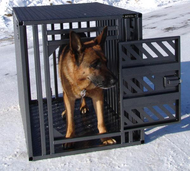Crate Training
Aug 17th 2015
Dog Crate Training
I am a firm believer in crate training for many reasons. First of all, when you house break a puppy it makes the transition from home to outside potty breaks much easier. A dog will generally not relieve themselves in their crate. To the dog it is their “den” or their “home.” My dogs know that in a crate it is their own time and a time they can relax. When my dogs are in a crate they are not working and it is their own space. Other than being quiet I do not expect anything of them when they are in the crate. If you have a young dog that barks and carries on when it first goes in a crate, do not give in. Check to make sure everything is ok and then leave the dog in the crate until they stop fussing. You can give them a chew toy or a bone so they will be distracted. They will get with the program and do as they should only if you don’t give in. My dogs will even use the crate with an open door as a resting place in my house. It becomes a secure place for them. Being crate trained in the house makes riding in a car kennel a natural position. Keeping your dog in a car kennel is the safest thing for them. A year ago I was in a car accident and was struck from the side while taking a service dog to visit a perspective handler. The dog was in a kennel/crate in the back seat of my truck and I believe the crate/kennel kept the dog from flying over the driver seat and being thrown into the windshield. There are many styles and sizes of crates. We make aluminum crates because they do not conduct much heat are light weight for moving and yet at the same time very strong. The dog I was transporting was in an aluminum crate. Since the accident I will not travel with a dog that is not crated. Having the dog in a crate also saves you from having to vacuum dog hair from the car regularly.
